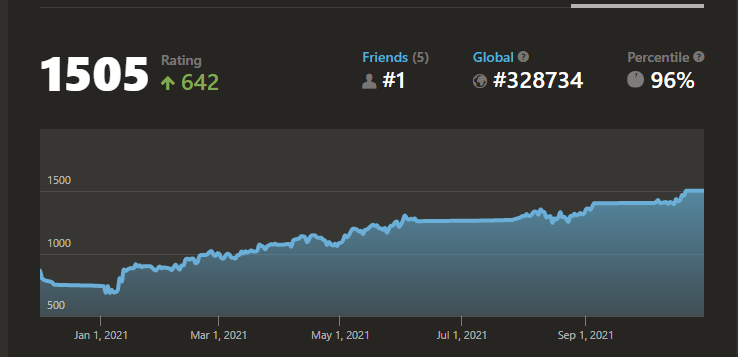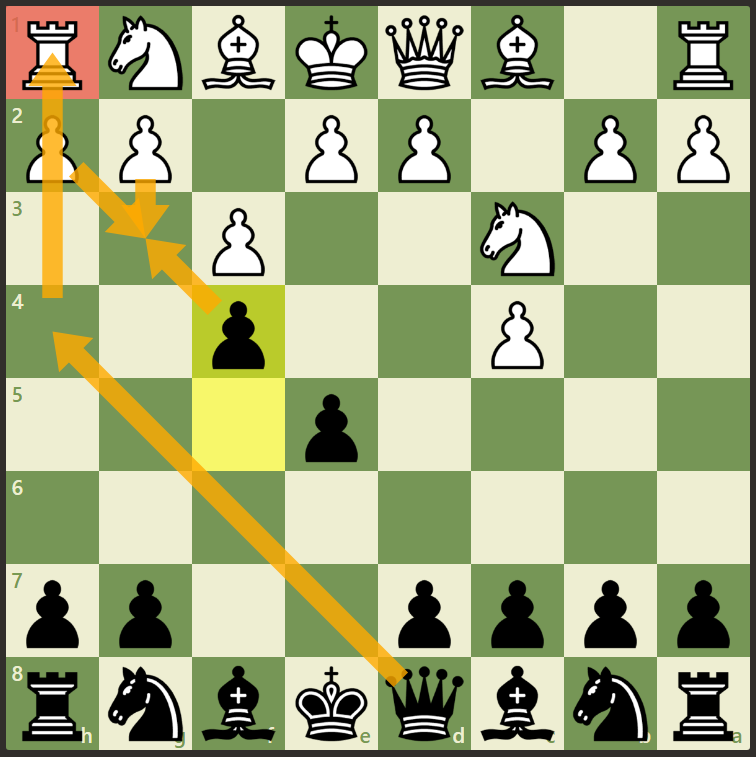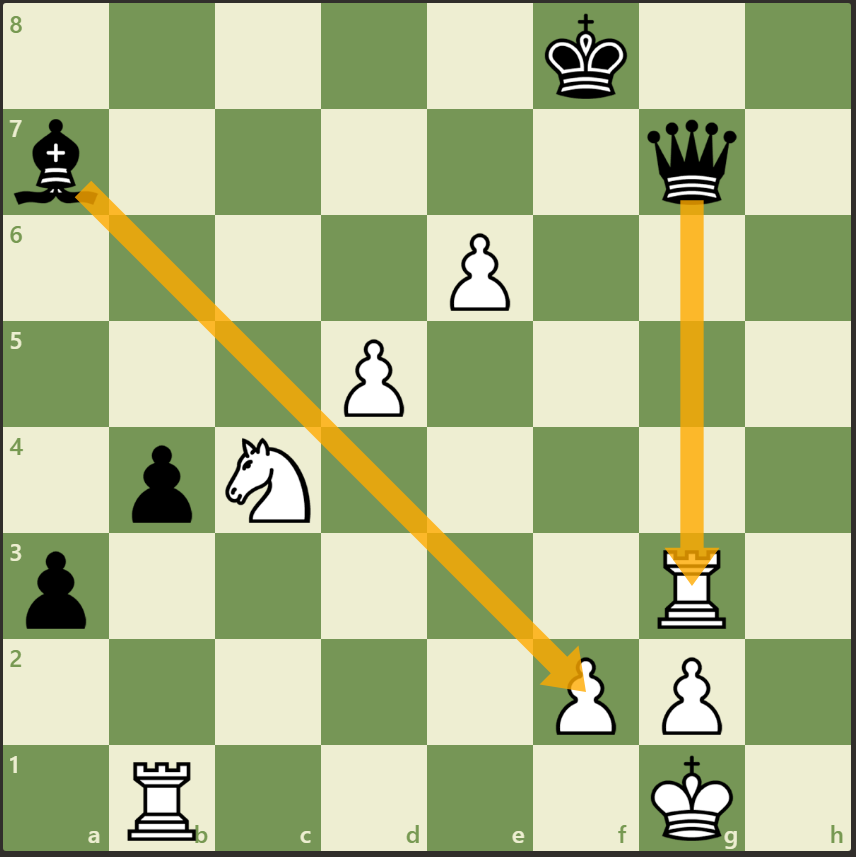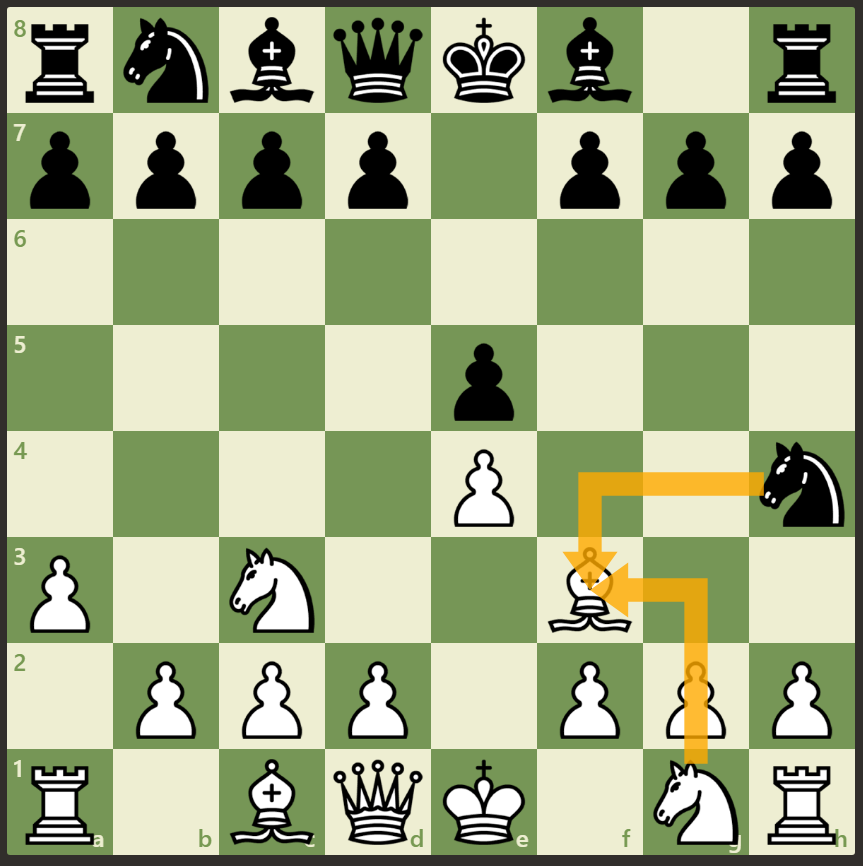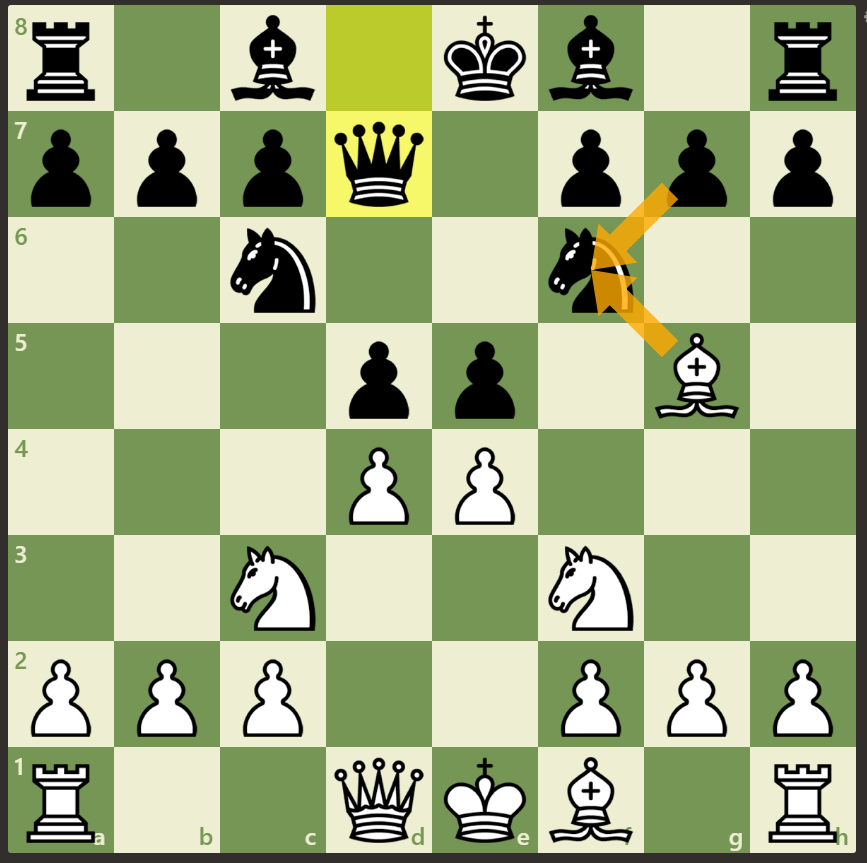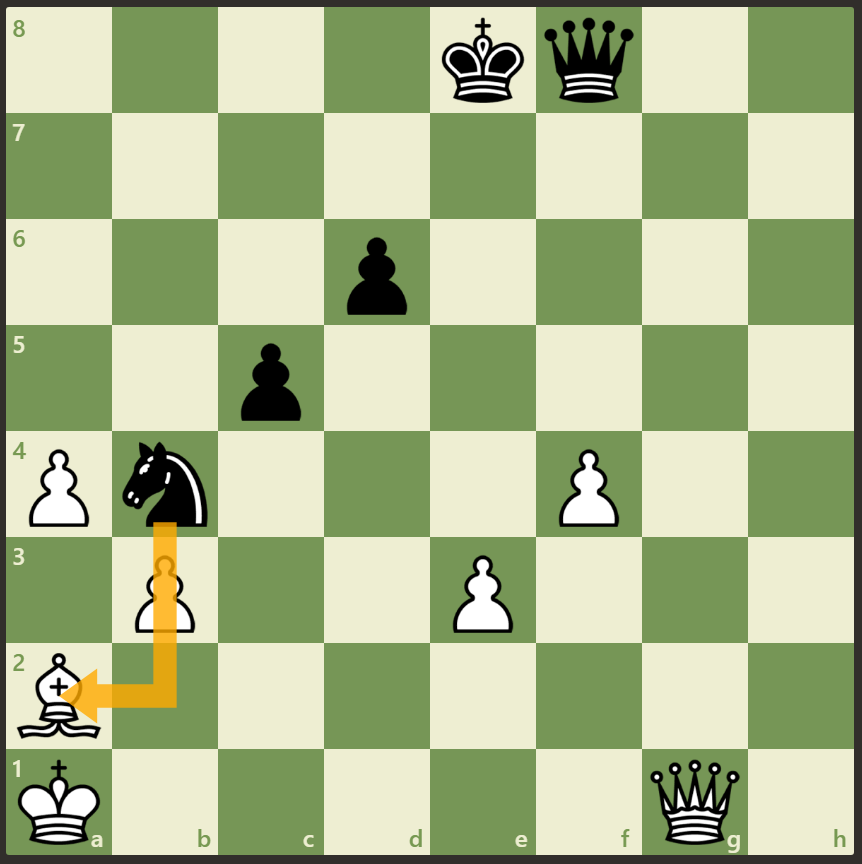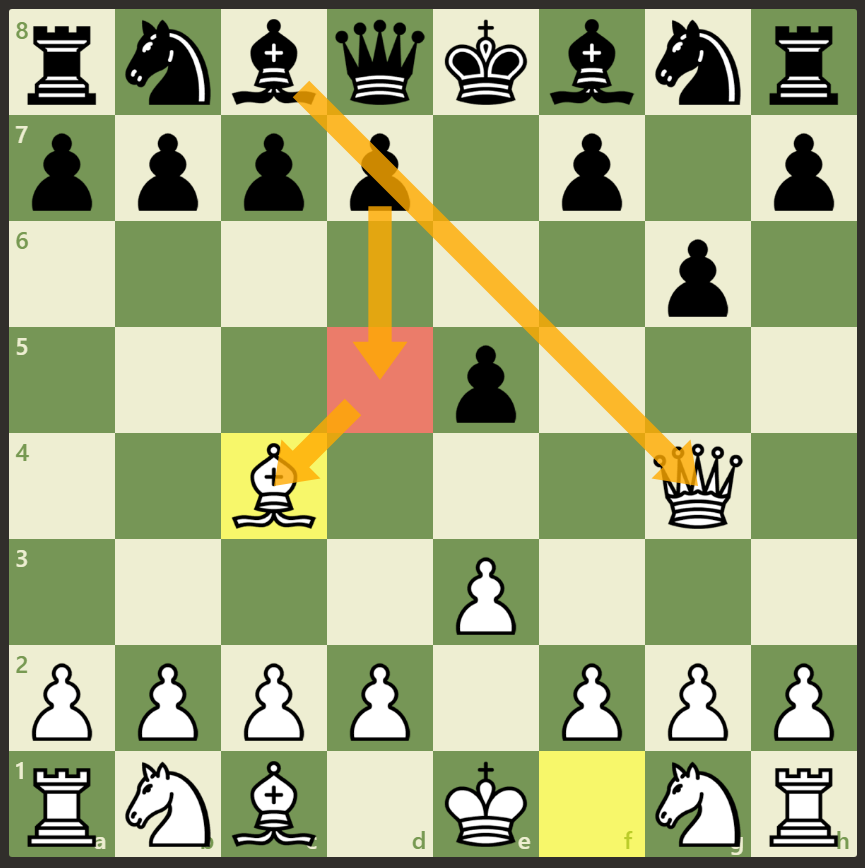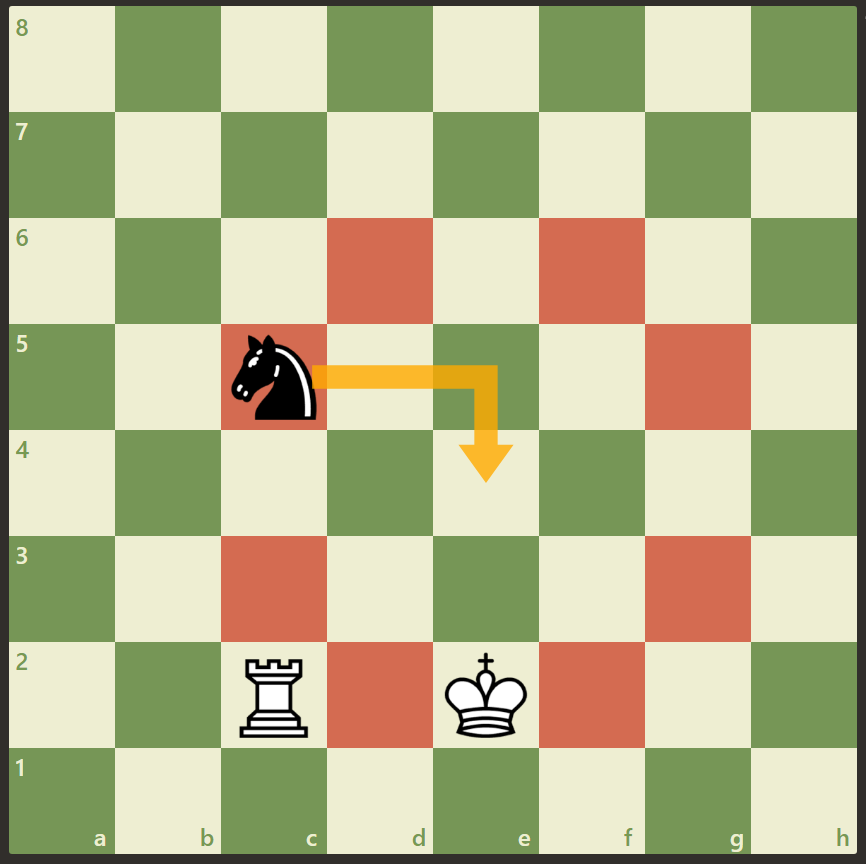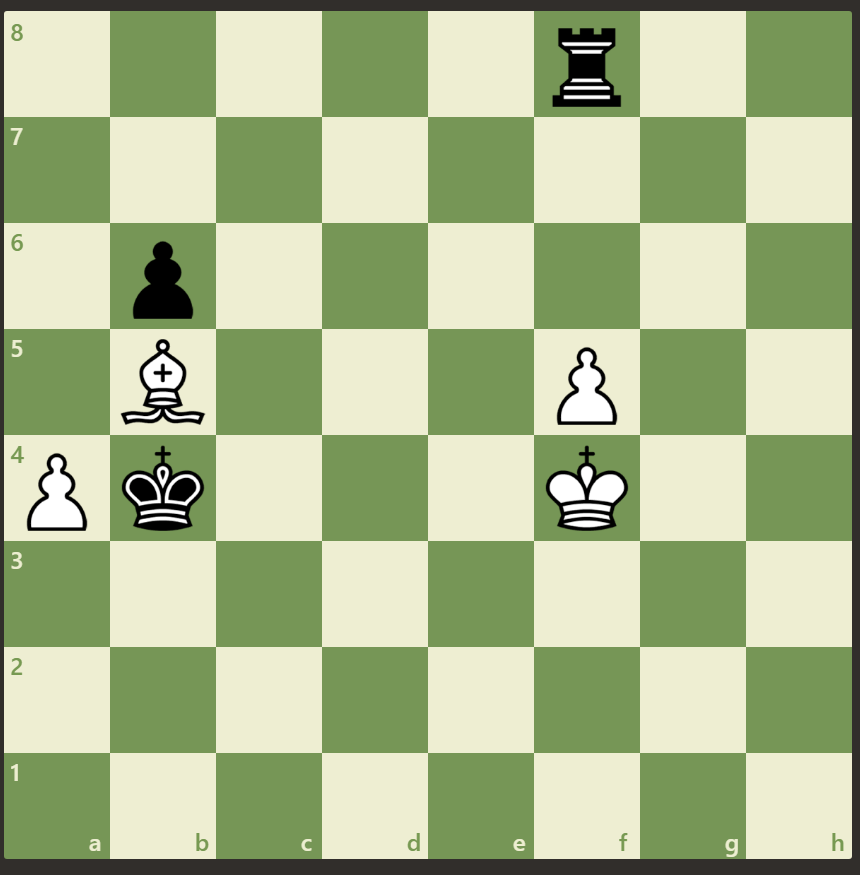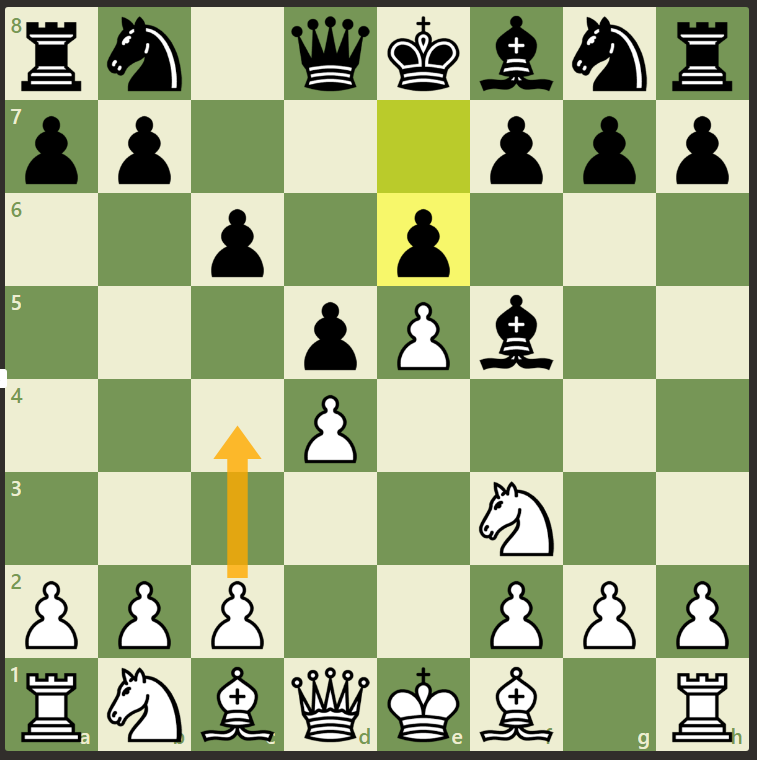25 ways to improve at chess
Since almost a year passed, I thought it would be a good time to reflect on how my game changed and what are the main things that I did or started paying attention to in order to improve and reach a decent intermediate level. As a result, I compiled a list of items
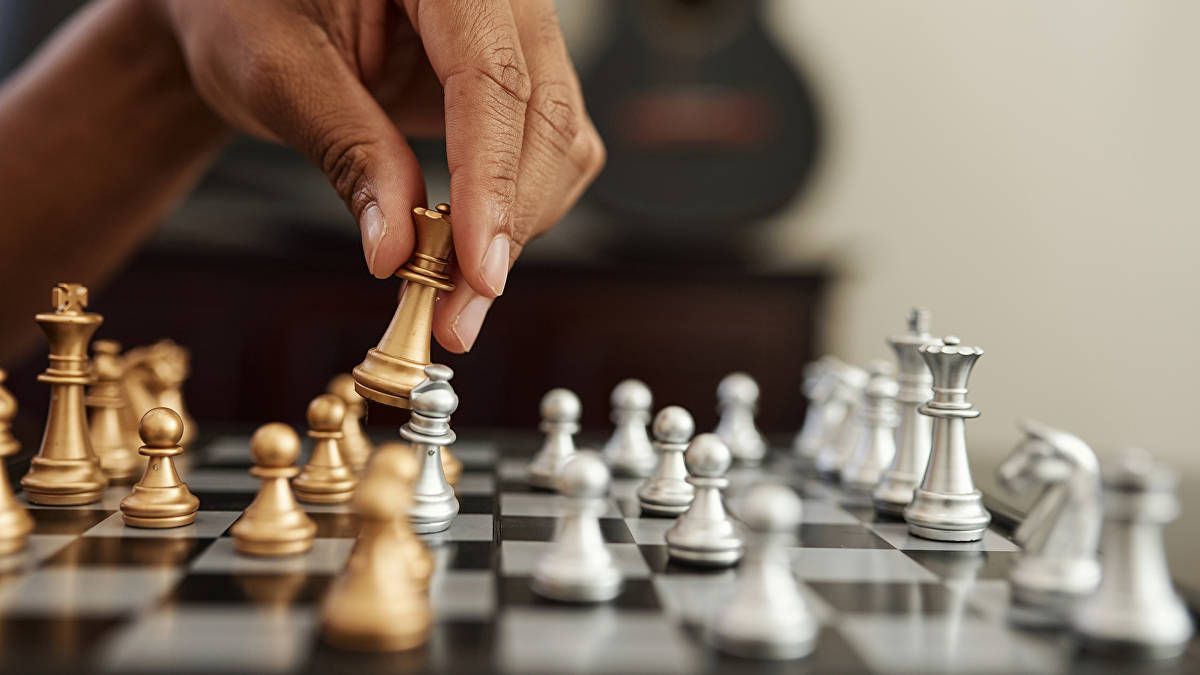
"Even a poor plan is better than no plan at all" - Mikhail Chigorin
I (re)started playing chess almost a year ago. I mostly played on chess.com which is free to play but you must pay for certain features like analyzing your game or doing puzzles. A quite good alternative is lichess which is completely free.
My starting level was that of a complete noob, not knowing anything other than how the pieces move. What really struck me while I was starting to make improvements to my play is how much depth this game hides under its relatively simple rules, something that I never appreciated as a kid when learning the basics of chess.
My initial calibration was somewhere around 600 Elo rating on chess.com. Slowly and steadily I started improving and recently I hit my all the time high rating of 1505. This is how my rating histogram looks like:
Since almost a year passed, I thought it would be a good time to reflect on how my game changed and what are the main things that I did or started paying attention to in order to improve and reach a decent intermediate level. As a result, I compiled a list of items that I want to share and hopefully it will help others who may be struggling to improve. Keep in mind these are general considerations and certain situations in the game might demand that you do the opposite of the advice presented here.
General tips
1. Analyze your games
I cannot stress enough how important this is. You need to look up your game and understand where things went wrong in order to improve and minimize the chance of doing the same mistake over and over. The depth at which you analyze your game can vary depending on how much effort you want to put into it and what your objectives are. Usually, I like to see where in the opening I did my first mistake, where in the game things really went south for me and what were the missed winning opportunities. I gloss over small inaccuracies since I think at my level those are not that important.
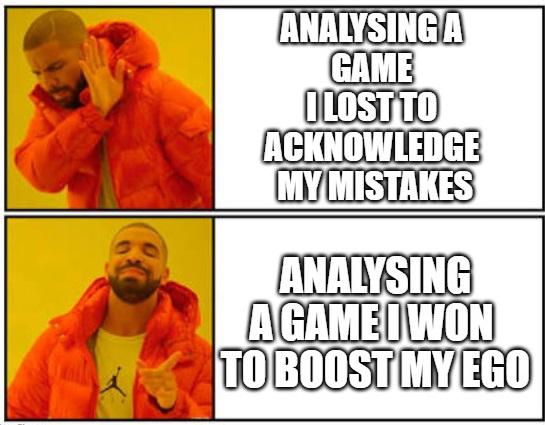
2. Do not play Blitz or Bullet games.
This goes hand in hand with the first advice, but low time controls will most of the time lead to games where you just get your adrenaline rush, without learning anything. Besides that, they are a lot more addicting since they take a short time to play and it is easy to say "just one more". Stick with at least 10-minute time controls or more. The only caveat here is that low time-controls can be quite useful when practicing new openings.
3. Try to understand the idea behind an opponent's move
During games, you reach a certain position and you start making a plan on how to attack your opponent. That is good and having a plan already puts you above a lot of players, but you need to keep an eye on what your opponent wants also. Most likely he will also have a plan and each move he makes is a clue to figuring out that plan. Every time your opponent makes a move try to think: why did he do that? What changed in his position? What new moves are enabled by this move?
An example from one of my recent games: I noticed the king's weakness caused by the opponent moving his f pawn and I pushed my pawn to f4. The idea is to check the king with my queen by going to h4, then because of my previous move the opponent cannot simply block my check with pawn to g3 because then I simply take back with my f4 pawn and white is in serious trouble(e.g. if he recaptures the pawn with the h2 pawn, he loses the rook to my queen). My opponent did not think about why I made that move and played pawn to e4, allowing all what I previously described.
4. Always scout the board for weaknesses
A lot of beginner players have trouble coming up with a plan on how to attack an opponent. I am not an expert myself on how to develop a sound attacking plan, but one piece of advice that I can give is that you need to be aware of your opponent's weaknesses. Scout the board and you will see that there are either some pieces completely unprotected or some pieces are overloaded protecting two or more other pieces, or some piece that looks like it protects something, it does not because it is pinned. Once you notice these things you can use them as the starting point of your attacking plan.
5. If you do not know what to do, just wait
Sometimes you reach a certain position and you do not know what to do anymore. You cannot find a way through your opponent's defense. That's ok, do not be pressured to make a stupid move just in the hope of making progress. Just move your pieces around a little, maybe improving your positions slightly, and wait for your opponent to make a very committal move. There is a high chance he also felt the pressure to make progress and might have gone with an inaccurate move to do so.
6. Do not give up
Even if you are down a couple of points of material, you should not give up on your games. Remember, you are not playing GMs. If you are under 1200, there is a high chance your opponent will not know how to mate with a rook and king. Every new move bears the potential for an opponent's blunder that would equalize the game. I had plenty of games that I won where I was almost out of time, but my opponent which had a big time advantage over me resigned because he blundered a piece. Do not be like that, just play the game until the end and make your opponent work for his win and you will get some unexpected draws or even wins.
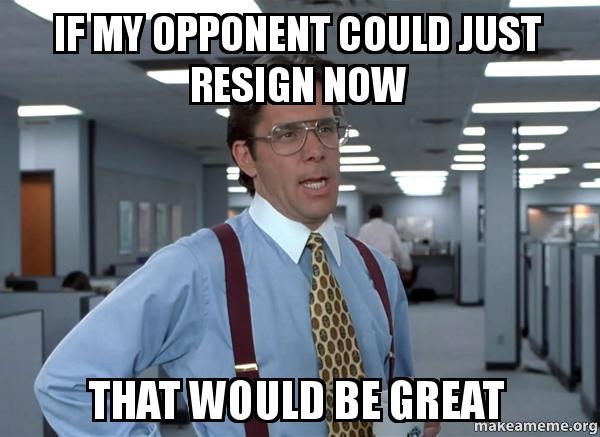
7. Learn one opening with white and always play it
When you start getting a little more serious about chess, you will start hearing about all these intriguing named openings(e.g. The Queens Gambit, The Blackmar Diemer Gambit, The Italian Game) and you will want to play all of them. Do not do that. When playing with white, try to focus on only one opening and learn it really well going deep in its different lines. The one I had quite good success with is The Vienna Game since most of the time your opponent will play into it and it is quite frontal putting your opponent quite quickly under pressure and hence possibly forcing mistakes from him.
8. Learn at a surface level some black defenses against common white openings
As black, you are a little more at the mercy of what your opponent will start with. Here I would advise you to look up your games and learn the first 5 mainline moves from the openings you encounter the most. Then you should get a playable position and applying chess common sense should get you a decent position going into the middle game. Sometimes your opponent will surprise you with some cheap trick and you might lose, but analyze the game and remember how to counter that trick for the next time you play against it.
Specific tips
9. Learn basic endgame
I must admit that probably endgames are one of my weaker points, but there are some things that everyone kind of has to know by heart because quite a lot of times you will have a very small amount of time remaining when you reach the endgame phase of the game. These are a couple of must-know items in my opinion: how to mate with king and queen/rook vs king, how to instantly know if a king can stop your passed pawn(i.e. the rule of the square), how and when you can promote with two connected passed pawns, king opposition in 2 kings and a pawn endgames.
10. Do not pin yourself
While sometimes it is useful to block a check instead of moving the king out of the way, try to avoid it as much as possible. As the game goes on, that pin will become a liability that your opponent will try to take advantage of since you are basically playing with one less piece. The advice goes also the other way, if you notice your opponent has pinned himself, try to attack the pinned piece or around it since it cannot defend anymore.
11. Pinned pawns
This is related to the previous advice, but I think it requires a special mention because it is a lot less obvious that a pawn is pinned and cannot really defend. Pay special attention both in your position and your opponent's position for such pawns and try to take advantage of his weakness while being aware when he could take advantage of your pinned pawn. Delayed long-diagonal pins with bishops are especially a lot less noticeable. Such an example is bellow: the white player was not paying attention and he thought the rook on g3 is protected by the pawn on f2, but it is not since the pawn is pinned by the bishop on a7 so the queen can just take the rook.
12. Do not trade if it helps your opponent develop
Chess is more or less a game of tempo. If I give you almost any chess position with unlimited turns while your opponent has none, you will probably be able to win the game. That's why during the game and especially during the opening, it is important to not give your opponent a turn in which he can gain a tempo on you by doing two things in one move. For example in the position below, black should not take the f3 bishop because it allows white to both recapture and develop a new piece at the same time.
13. Force trades that damage the opponent's structure
If you are a beginner you probably do not think a lot about this, but the structure of your pawns is important. Pawns are strong when they are adjacent to each other(aka "connected") because they can protect each other. Once you double or triple your pawns on a file, they will be a lot weaker and will be easy targets for your opponent. This becomes even more obvious in the endgame. So look for opportunities where a piece of your opponent is guarded only by a pawn and force a trade with it since that will damage his structure. In the example below, white should take the knight on f6 with the g5 bishop, because black will have to double his pawns on the f file if he wants to recapture. It is not only bad because of the doubled pawns, but it also makes short castling not a very safe option for black because the g file becomes semi-open.
14. Do not trade your good pieces for the opponents bad pieces
Even though two pieces might have equal theoretical material value, in games the practical value of a piece will be different depending on how active it is. For example, look at the bishop on a2 below. That bishop is basically dead: it is blocked by its pawns and also it has no real targets against the white pieces. You could say that practically the bishop is worth 2 or fewer material points. The black horse on the other hand is dominant there and has the flexibility to threaten the white position being virtually unopposable. From a practical standpoint, that horse is worth at least 4 material points if not more. So in this situation, it is very bad to make the horse for bishop trade from black's point of view. This example is quite obvious, but try in your games to judge how active is your piece vs the opponent piece before making what could seem an "equal" trade.
15. Guard against forks
Being forked is one of the worst feelings in chess because it gives you this feeling of helplessness where you are forced to lose material most of the time, so it is best to avoid it. And remember what a lot of people forget: not only a horse can fork you(although those are the most tricky)! Pawns, Bishops, Rooks, the Queen and even the King can fork. Pay special attention to forks that come with a check since then your potential for counterplay is really minimal.
16. Moving a pawn creates weaknesses
This is again something that I started really paying attention to after I was above 1200 in rating. You need to internalize the idea that a pawn is always fighting for two squares, its top-left and top-right squares. When you move a pawn it starts fighting for two new squares, but more importantly, it stops fighting for the old ones. The second point to internalize is that a pawn cannot move backward as opposed to all other pieces, so once you move a pawn forward it is committed and there is no turning back, your position is forever transformed. A lot of players will leash with a pawn forward to attack a piece, that piece will simply move out of the way and then they are left with a pawn out of position and weak unguarded squares behind it. Sometimes these weak squares will mean that you left a piece hanging, but even if you didn't, it lets your opponent occupy those squares and possibly plant an outpost on them.
17. Pay attention to discovered attacks
This is a common blunder by beginners. Try to pay attention to what piece gets unblocked after your opponent moves and see if it threatens any of your pieces. That is the first step. The next level is to pay attention to a double discovered attack where both the piece that moved and the piece whose path becomes unobstructed attack a piece. A common situation that you might encounter is the one below: black can move the d7 pawn to d5. By doing so, the white queen is being attacked by the bishop on c8 and the white bishop on c4 is being attacked by the pawn. White will lose material here so be very careful when a heavy piece like the queen is aligned with an enemy rook or bishop even when the path between them is blocked by some other piece because that is just temporary.
18. Quickly calculate the threats of a horse
A horse is a very valuable asset in closed positions since it can jump between pawn blockades. It is also a little tricky to visualize what exactly it is threatening compared to the other pieces which are directly threatening a target. This becomes a lot more stressful to calculate in low-time situations. What worked for me are the following tricks:
- A horse attacks only squares of a certain color at a time, so if you are worried about a possible fork between two pieces, if they are on different colored squares then a fork is not possible.
- When a horse moves, it changes the color of the squares which it attacks, and the square color which it attacks is the opposite of its own square color. E.g if the horse is stationed on a light square, it attacks only dark squares. When it moves it can only move to a dark square and it will attack light squares. With that in mind, you can quickly determine if a horse being moved will threaten one of your pieces or not. If before the horse moves your pieces are on the opposite square color of the horse then they will not be threatened by the horse when it moves.
19. Anchor your bishop to a pawn
In endgames when there are not a lot of pawns left, it can be very difficult for your opponent to deal with a bishop anchored to a pawn. They both protect each other so your opponent has to either exchange one of his pieces for it or in a lot of scenarios sacrifice a higher value piece to deal with it. If no other pieces are left that can threaten the bishop, then the pair can leave forever there. In the position below, despite black having a 6 to 4 material advantage, the pawn anchored bishop makes white actually ahead in this endgame(that and of course its f5 passed pawn).
20. Do not blunder pawns
Until 1200 rating I was not really paying attention to pawns. I was making sure all my higher value pieces are protected, but I was letting my pawns be taken for free by opponents. I thought that they are not worth protecting and the opponent is just wasting a move taking a worthless pawn. That is wrong. Pawns are very important. They usually lead the initiatives you take and also allow you to make breaks in closed positions that can lead to winning attacks. Sometimes it makes sense to sacrifice a pawn in order to open a file for a rook for example, but most of the time take care of them like you take care of your other pieces.
21. Make pawn breaks
Most beginner players struggle with closed positions because they do not know how to make progress in such situations. And that is because usually they like to move only their higher value pieces and do not pay attention to pawns that much. And that is a mistake. Your pawns should lead the way and using pawn breaks you can open a position and transform it in an advantageous way. Here is an example from one of my recent games. I wanted to disrupt the strong center black had with his triangle of pawns there so I made my move for a pawn break with c4. One thing to keep in mind is to actually make the capture only when you think its best. Most of the time it is good to keep the tension between the pieces and let the threat of capture put pressure on your opponent. For example in this case I did not immediately take his d5 pawn because he would actually still be able to keep a strong pawn chain by capturing with either c6 or e6. I was not afraid of him capturing my pawn because then I could immediattely recapture with the light square bishop while at the same time developing it.
22. Pieces can move backward
A lot of times we are so focused on making progress and advancing towards the enemy king that we forget that pieces can also move backward. And because of this, we might miss checks, forks, pins, and other tactical or positional advantages. So when looking for possible moves consider also backward ones, not only forward ones.
23. Be aware of the horse repositioning concept
Horses are very peculiar pieces because of the way they move. One valuable tip regarding them is to look at your position and think about where would you like your horse to be. Once you establish that, see where your horse is and what path it can take to reach that ideal position. A lot of lower-rated players stop if their horse cannot jump directly to the desired position. Do not let that stop you, it is perfectly ok to move your horse multiple times to reach its optimal place on the board.
24. Trade bishops of the same color as the majority of your pawns
This is already a more advanced concept, but try to keep it in mind. Either by accident or by intention, in a lot of situations you will end up with the majority of your pawns either on the light squares or on the dark squares. The consequence of that is that the bishop of the same color as to where your pawns are will have limited mobility since it will be blocked by the pawns. That's why it could be a good idea to trade it for one of your opponent pieces since it has limited value for you anyway. This is a specific example of the previous advice of trading your bad pieces for your opponent's good pieces.
25. When having a significant material advantage just sacrifice into a winning endgame.
This is another mistake I see people doing quite often. They are ahead by a lot, but are afraid of sacrificing material to reach a completely winning endgame. Even if your opponent is down by a lot, as long as he has a decent amount of pieces he can still create counterplay, but if he has only his king left then he has almost zero counterplay. It doesn't matter if you checkmate him by having a +5 material advantage or having +20 so simplify as much as you can. The only thing you need to be aware of is what endgames end in a draw: King and Bishop or King and Horse vs King is a draw since you cannot checkmate with those pieces. I would say also king and 2 bishops vs king is probably also a draw for most of us because it is quite hard to mate with them although certainly possible if you study the technique.
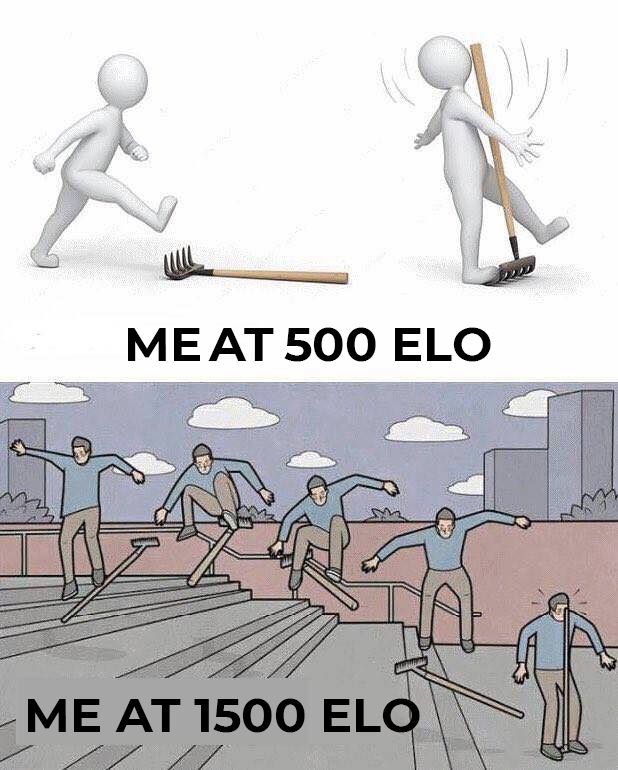
Do you think there are more valuable tips for players rated 1000-1600 or do you think that some tips from this list are wrong? Let me know in the comments!

